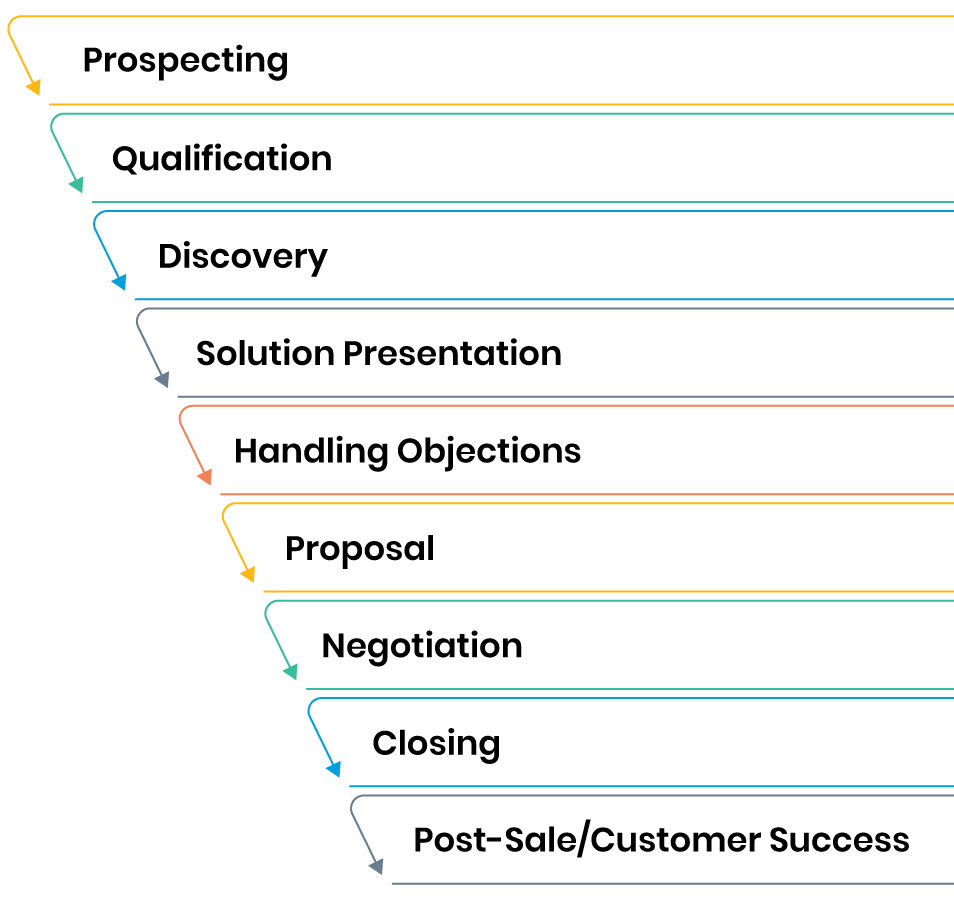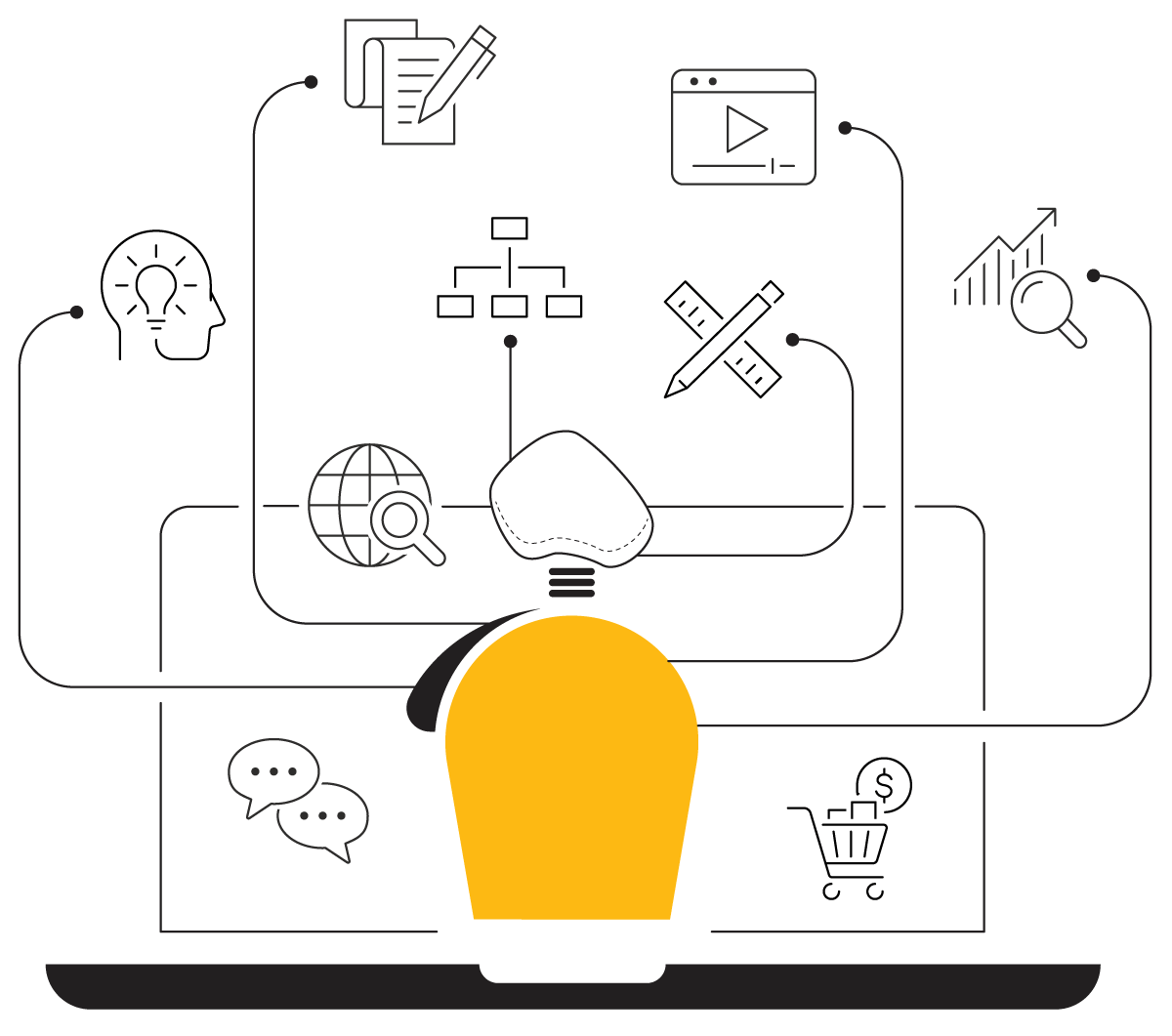Why Process Matters in B2B Sales
Imagine working on a deal after four months of work, only to learn in legal review that a data-processing addendum was required and nobody surfaced it earlier. The opportunity slips, the quarter closes, and all of your momentum evaporates. That scenario is common because modern B2B buying is genuinely hard: 77% of buyers describe their last purchase as complex or difficult, and a typical decision involves six to ten stakeholders who must reconcile competing priorities.
In this environment, sales isn’t about persuasion as much as guidance. A well-defined, consistently executed B2B sales process gives buyers clarity, speeds internal alignment, and reduces decision fatigue, which is why teams with a formalized process grow revenue faster. Multiple analyses report a meaningful lift. For example, organizations with a formalized sales process see 18% higher revenue growth than those without one.
The bottom line? A strategy without a process is incomplete. In a world of long sales cycles and complicated buying journeys, a strong process isn’t red tape. It’s how great revenue teams create predictability, forecast with confidence, and close more deals.
What Is the B2B Sales Process?
At its core, the B2B sales process is a sequence of intentional, buyer-aligned steps that move a prospect from initial interest to closed-won, and beyond, into value realization. Unlike B2C, where purchases are fast and individual, B2B decisions are committee-driven, longer, and constrained by risk, compliance, and integration needs. While the exact number of stages varies by company and deal complexity, what matters most is that each stage is:
- Clearly defined
- Aligned to a specific buyer milestone
- Paired with exit criteria based on buyer actions—not rep opinion
The sales process is the go-to-market backbone that ties together teams across revenue functions—sales, marketing, sales development, solution engineering, RevOps, and customer success. Without it, even the most promising leads get lost in the shuffle. With it, every rep can deliver a consistent, high-quality buying experience that accelerates time-to-value.
What does a typical B2B sales process look like?
While no two companies structure their sales process identically, the most effective B2B sales orgs follow a version of these nine b2b sales process stages—each aligned to how today’s buyers actually make decisions, not just how sellers want to close deals.

- Prospecting
Identify and reach out to potential businesses that fit your ideal customer profile (ICP) using channels like cold outreach, referrals, inbound marketing, or social selling.
-
- Mistake to Avoid: Spraying generic messages without personalization. It erodes trust and wastes time.
- Mini Case: A SaaS company used LinkedIn Sales Navigator to target IT directors at mid-sized logistics firms, resulting in an increase in discovery call bookings within one quarter.
- Qualification
Assess whether the prospect has the budget, authority, need, and timeline to buy.
-
- Mistake to Avoid: Assuming interest = readiness to buy. Skipping qualification can lead to wasted pipeline clutter.
- Mini Case: A cybersecurity firm disqualified a prospect after realizing the company was still under a restrictive multi-year vendor contract, saving weeks of follow-up and misaligned demos.
- Discovery
Dig deep into the prospect’s challenges, goals, and existing processes to position your solution with precision.
-
- Mistake to Avoid: Turning discovery into a product pitch. Listen more than you talk.
- Mini Case: During discovery, a data provider uncovered that a retail chain’s churn was tied to fragmented customer data, a pain point their platform directly solved, leading to a fast-track proposal.
- Solution Presentation
Develop and present a tailored solution that aligns with the prospect’s business goals, KPIs, and pain points.
-
- Mistake to Avoid: Delivering a canned demo that doesn’t reflect the buyer’s specific needs.
- Mini Case: An AI vendor closed a six-figure deal after customizing their presentation to mirror the client’s own internal dashboards and customer journey maps.
- Handling Objections
Objections are signals, not stop signs. Treat them as requests for proof and answer with evidence tied to outcomes.
-
- Mistake to Avoid: Debating hypotheticals. Anchor answers to facts and agreed success metrics.
- Mini Case: By turning a “too hard to implement” objection into a two-week pilot with clear adoption targets, a team converted a stalled deal into a signed agreement.
- Proposal
Package scope, pricing, timeline, and success metrics into options tied to the business case so the committee can choose, without restarting the debate.
-
- Mistake to Avoid: One-size pricing. Match options to phases when risk is high.
- Mini Case: A phased proposal let a cautious buyer start with a 90-day rollout while preserving the multi-year plan, shortening time-to-sign by two weeks.
- Negotiation
Align on final terms like pricing, timelines, SLAs, or contract language in a way that preserves value on both sides.
-
- Mistake to Avoid: Over-discounting out of fear. It devalues your offer and sets a poor precedent.
- Mini Case: A logistics SaaS provider negotiated a three-year contract by offering a slight discount in exchange for a multi-region pilot case study.
- Closing
Secure the final agreement, get signatures, and officially kick off the engagement.
-
- Mistake to Avoid: Going silent after sending the contract. Follow-up is still part of selling.
- Mini Case: A CRM vendor reduced close time by 40% by integrating contract e-signing and approval routing into their sales stack.
- Post-Sale/Customer Success
Ensure smooth onboarding, adoption, and value realization to turn new clients into loyal advocates.
-
- Mistake to Avoid: Handing off too quickly without context. Continuity builds trust.
- Mini Case: A B2B fintech company increased customer retention by 25% after assigning dedicated Customer Success Managers and building onboarding dashboards tied to client goals.
Frameworks for Structuring the Process
Methodologies can supercharge your process by providing structure for qualification, discovery, messaging, and forecasting. When chosen and applied correctly, a B2B sales framework brings consistency to how reps approach every stage of the deal.
The most widely adopted include:
- SPIN Selling: Focuses on asking questions that uncover the buyer’s Situation, Problem, Implication, and Need-payoff. Great for improving early-stage discovery.
- Challenger Sale: Best suited for crowded markets and long status quo cycles, Challenger emphasizes insight-driven selling: teaching the buyer something new about their business that leads to your solution.
“What sets the best suppliers apart is not the quality of their products, but the value of their insight—new ideas to help customers either make money or save money in ways they didn’t even know were possible.”
— Matthew Dixon, author of The Challenger Sale: Taking Control of the Customer Conversation
- MEDDICC: Ideal for complex deals, this framework helps teams assess and validate buyer readiness using six (or seven) components like Metrics, Economic Buyer, Paper Process, and Champion.
- Sandler Method: Prioritizes control of the sales process through upfront contracts, mutual commitments, and structured objection handling.
Example Sales Process in Action
The best way to understand a B2B sales process is to see it in action. Below are two distinct B2B sales process examples that illustrate how structure, strategy, and alignment play out across different industries and deal types.
Example 1: Mid-Market SaaS: Structured, Scalable, and Fast
A SaaS company offering CRM tools to 200–500 seat customers uses MEDDICC to qualify deals early and avoid pipeline bloat. Their process kicks off with precise ICP scoring, followed by a SPIN-style discovery call that reveals stakeholder pain points and triggers urgency.
After the demo, reps co-create a mutual action plan (MAP) to align stakeholders and timelines and proactively pull legal and InfoSec review into the “validation” stage, before verbal commitment. Since adopting MAPs, they’ve shortened their average sales cycle by 22% and improved forecast accuracy across all segments.
Example 2: Enterprise Manufacturing: Complex, Consensus-Driven Sales
A manufacturing supplier selling into national grocery chains must navigate long buying cycles and complex stakeholder dynamics, including supply chain, sustainability, finance, and operations.
Their reps lead with pilot programs that showcase unit cost savings and ESG compliance, then build an executive-ready business case tailored to each stakeholder’s lens. A shared MAP details every internal milestone: legal review, IT approval, procurement sign-off. This method reduced last-mile delays and increased their enterprise close rate by 19%.
Common Sales Process Challenges (and Fixes)
Even high-performing sales teams run into recurring issues. These problems aren’t usually about individual rep performance; they’re about process gaps that can be fixed with the right structure and tooling.
Here are some common breakdowns and how to address them:
- Long cycles.
Bloated timelines drain resources and hurt forecast accuracy. As a fix, track metrics like time-in-stage and sales cycle length to spot slowdowns. Use this data to coach reps, streamline approvals, and prioritize high-velocity deals. - Poor handoff to customer success.
A rocky transition from sales to CS leads to missed expectations, delayed onboarding, and lower retention. Fix this by documenting key context in CRM, sharing the mutual action plan, and defining “first value” as a shared metric across Sales and CS. - Lack of documentation.
When deal details live in rep notes or Slack threads, handoffs and forecasting suffer. Require reps to log MEDDICC components, decision criteria, and key stakeholders in the CRM. Bonus: this also improves pipeline inspection and coaching.
Process Gaps to Fix
Many common sales challenges stem from breakdowns in process, not people. Here are six areas to audit and improve:
- Unclear next steps stall deals
Use mutual action plans to define shared milestones and keep momentum. - Qualification is inconsistent
Apply a framework like MEDDICC and track progress using verifiable buyer actions. - Customer Success handoffs are bumpy
Document key deal context in your CRM and align both teams around time-to-first-value. -
Critical details aren’t documented
Ensure decision criteria and stakeholder info live in structured fields—not scattered notes. -
Legal slows down late in the game
Start security, procurement, and legal reviews early, ideally during validation. -
Single-threaded deals disappear
Build relationships with multiple stakeholders from the beginning to reduce risk.
Optimizing Your Sales Process with Tools
Technology should streamline your sales process, not slow it down. The best tools enhance visibility, drive consistency, and support reps in delivering a high-quality buying experience—stage by stage.

Here’s how to think about your stack:
CRM Platforms
Examples: Salesforce, HubSpot
Your CRM is the single source of truth for pipeline activity. Use it to track deals by stage, enforce exit criteria (e.g., “economic buyer identified”), and improve forecast accuracy. Custom fields and reports tied to your process framework (like MEDDICC) make inspection and coaching easier.
Sales Engagement Tools
Examples: Outreach, Salesloft
These platforms automate personalized outreach across email, phone, and social. Beyond sequencing, they help ensure timely follow-ups, improve rep productivity, and drive consistent top-of-funnel execution.
Enablement and Content Management
Examples: Gong, Highspot
Surface the right materials at the right stage—from case studies to one-pagers to competitive battlecards. These tools help sellers tailor content to buyer concerns and track usage for marketing-sourced collateral.
AI in the Sales Process
AI is increasingly baked into all of the above. Use it for:
- Qualification: Score leads based on fit and intent signals.
- Forecasting: Spot deal risks early based on buyer activity.
- Call Coaching: Generate summaries, detect missing discovery topics, and flag competitor mentions in real time.
Don’t overload your reps with tools. Begin with one core tool per stage—CRM, engagement, enablement—and layer on intelligence platforms once your foundation is consistent.
Tips for Creating a Structured Sales Process
According to the Sales Management Association, organizations with a formal sales process see 18% higher revenue growth and 13% shorter sales cycles than those without one.
It can seem daunting, but building a high-performing B2B sales process doesn’t mean starting from scratch; it means making intentional choices based on your buyers, segments, and go-to-market motion. The following B2B sales process steps offer a proven foundation for designing a process that’s measurable, scalable, and aligned with how your customers buy:
- Start with Your ICP and Buyer Journey
Define your Ideal Customer Profile (ICP) based on firmographics, technographics, budget range, buying triggers, and decision complexity. Segment accounts into tiers based on deal size, lifetime value, or strategic fit so reps know where to focus time and resources. - Break It Down Into Clear Stages
Create 6–8 sales stages tied to buyer intent, not just seller activity. For example, instead of a stage like “Demo Complete,” use one like “Problem and Success Criteria Confirmed.” That way, movement reflects real buyer progress. - Standardize Activities at Each Stage
Assign specific exit criteria to every stage, ideally Verifiable Customer Actions (VCAs). Examples: “Security review scheduled,” “Pilot scope agreed,” or “Economic buyer identified.” VCAs make the process inspectable and help reps focus on meaningful progress. - Assign Roles and Responsibilities
Align sales, solutions, RevOps, and customer success teams around who owns what at each stage. For example: Sales drives discovery, Solutions supports validation, CS leads onboarding. Document handoffs clearly to avoid gaps. - Integrate CRM and Tools
Make your process actionable by configuring your CRM and tools to reflect it. Use fields, reports, and dashboards to log exit criteria, surface stage-specific assets, and coach against the right behaviors. This is where tools like Salesforce, Outreach, and Gong shine. - Make It Measurable
Track conversion rates, time-in-stage, and win/loss reasons. Monitor how each stage performs across reps and segments. Use this data to fine-tune your process and prioritize coaching. - Build in Flexibility
Not every deal will follow the happy path. Train your team to recognize edge cases (e.g., technical champion but no executive sponsor) and use frameworks like MEDDICC or SPIN to guide decision-making without rigid scripting. - Pilot and Iterate
Start with a pilot group to test the structure. Collect feedback, review deal outcomes, and adjust as needed. The goal isn’t perfection, it’s continuous improvement based on what actually works.
B2B Sales Process Best Practices
To turn your B2B sales process into a growth engine—not a bottleneck—it’s essential to combine structure, buyer empathy, and continuous enablement. These best practices help ensure that every stage of your process drives forward momentum, cross-functional alignment, and better win rates.
- Put the Buyer First
Design each stage around what the buyer needs to feel confident making a decision, not just what the seller needs to check off. A structured sales process should guide the buyer through their journey with clarity, insight, and reassurance.
“You know what buyers pick as the differentiator in their decisions? The sales experience itself — what it’s like working with you during the course of all your interactions. They think this experience as a whole is more important than all the other factors combined.”
— Jill Konrath, author of Agile Selling: Get Up to Speed Quickly in Today’s Ever-Changing Sales World
- Emphasize Qualification Early
Avoid wasting time on deals that won’t close. Use qualification frameworks like MEDDICC or BANT to prioritize the right accounts. Standardize qualification in your CRM and make it a front-line coaching priority. - Leverage Multi-Channel Outreach
Today’s B2B buyers engage across channels. Combine email, phone, social, and in-product messaging to increase your chances of connecting. Sales engagement platforms like Outreach and Salesloft help automate this in a coordinated, trackable way. - Enable Data-Driven Decisions
Going with your gut won’t scale. Use data to inspect pipeline health, stage conversion rates, and win/loss reasons. Set clear stage exit criteria based on verifiable customer actions (VCAs), so you’re forecasting based on facts, not optimism. - Focus on Personalization
Personalization goes beyond dropping a name in an email. Tailor your pitch, content, and business case to the buyer’s vertical, pain points, and priorities. Tools like Highspot and Gong can surface the right collateral and message timing automatically. - Collaborate Across Teams
The sales team doesn’t win deals alone. Loop in Solutions, Marketing, and Customer Success at key stages. This cross-functional coordination strengthens the business case, reduces friction during handoff, and builds trust with the buying committee. - Invest in Training and Coaching
Your process is only as strong as your team’s ability to execute it. Enable managers to coach consistently on stage progression, qualification, and mutual action plan momentum. Use conversation intelligence tools to guide coaching with real call data. - Document and Share Learnings
Codify what works. Whether it’s a winning objection response or a successful deal map, share it in your enablement hub so others can learn and replicate. This helps scale tribal knowledge and continuously improve your process.
Ready to put process into action? See B2B Sales Negotiation Tactics next.
Key Takeaways
- A structured B2B sales process makes buying easier. With more stakeholders and longer cycles, the process must guide, not pressure, buyers through complexity.
- Each stage should reflect a buyer milestone, not a seller task. Define success using verifiable customer actions (VCAs) that track real progress.
- Frameworks make your process stronger. Use tools like MEDDICC and Challenger to improve qualification, messaging, and stakeholder management.
- Mutual action plans drive clarity and accountability. When both sides know what’s next, deals close faster and with less friction.
- Operationalizing your process in your CRM and engagement stack is critical. Without visibility, you can’t manage what matters.
- Process quality compounds. Teams with a majority adoption of a documented sales process consistently outperform on quota attainment, win rates, and forecast accuracy.
FAQs
A structured sales process helps teams operate with clarity and consistency, especially as organizations scale. It drives better forecasting, faster onboarding, and stronger alignment between Sales, Marketing, and Customer Success.
While every company adapts their process, a common structure includes: prospecting, qualification, discovery, solution presentation, objection handling, proposal and negotiation, and closing with onboarding. Some teams also include post-sale stages to support expansion and renewal. The key is aligning each stage to meaningful buyer progress, not just internal activity.
There’s no one-size-fits-all answer. MEDDICC is great for qualification and complex sales cycles. Challenger works well for teaching and reframing buyer thinking. SPIN Selling supports deep discovery. High-performing teams often blend elements of each depending on their market and deal size.
It varies by industry and deal complexity. A mid-market SaaS deal may close in 60–90 days, while enterprise manufacturing or healthcare sales can take 6–12 months or more. That’s why stage-specific benchmarks and time-in-stage metrics are critical for optimization.
Watch for signs like deals stalling late in the cycle, missed forecasts, low CRM adoption, or sloppy handoffs to Customer Success. These issues often trace back to unclear stage definitions, weak qualification, or misaligned tools—not just rep performance.
Yes—and it’s already happening. AI can score leads, surface next-best actions, summarize calls, flag risk in deal conversations, and even draft follow-ups. Tools like Gong, Clari, and HubSpot AI are making this more accessible for B2B teams of all sizes.






